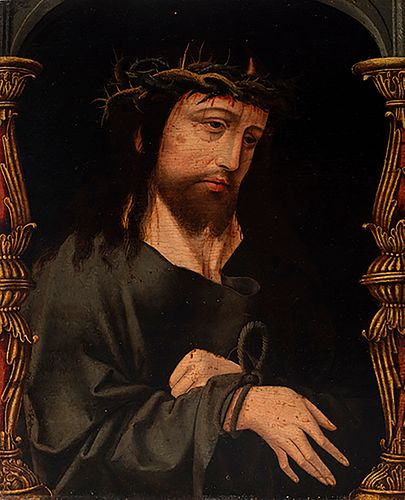Flemish school, ca. 1520. "Ecce Homo. Oil on panel.
Lot 88
About Seller
Setdart Auction House
Carrer Aragó 346
Barcelona
Spain
Setdart Subastas was born in 2004 and is currently the first online art auction in Spain with solidity, prestige and reliability guaranteed by our more than 60,000 users. Setdart has a young, dynamic and enterprising team ready to successfully manage the purchase and sale of art works through custom...Read more
Estimate:
EUR€10,000 - EUR€15,000
$10,416.67 - $15,625
Absentee vs Live bid
Two ways to bid:
- Leave a max absentee bid and the platform will bid on your behalf up to your maximum bid during the live auction.
- Bid live during the auction and your bids will be submitted real-time to the auctioneer.
Bid Increments
| Price | Bid Increment |
|---|---|
| EUR€0 | EUR€10 |
| EUR€200 | EUR€25 |
| EUR€500 | EUR€50 |
| EUR€1,000 | EUR€100 |
| EUR€3,000 | EUR€200 |
| EUR€5,000 | EUR€500 |
| EUR€10,000 | EUR€1,000 |
| EUR€20,000 | EUR€2,000 |
| EUR€50,000 | EUR€5,000 |
About Auction
By Setdart Auction House
Oct 20, 2021
Set Reminder
2021-10-20 07:30:00
2021-10-20 07:30:00
America/New_York
Bidsquare
Bidsquare : OLD MASTERS
https://www.bidsquare.com/auctions/setdart-auction-house/old-masters-7700
Setdart Auction House sofia@setdart.com
Setdart Auction House sofia@setdart.com
- Lot Description
Flemish school, ca. 1520. "Ecce Homo. Oil on panel. Size: 38 x 29 cm. The work that occupies us, belonging to the Flemish school, is worked with the precise and meticulous brushstroke, of enormous realism, that characterized the Flemish already from the XV century. On a dark neutral background, the snowy skin of Jesus stands out, bringing great luminosity to the scene, as well as the columns that frame it, with fluted shaft and topped by an arch. During the 15th century, the realistic style of the Netherlands had a great influence abroad, especially in Italy, but in the 16th century the panorama was reversed. The Italian Renaissance spread throughout Europe, and Antwerp became the center of the Flemish school, displacing Bruges and functioning as a center for the penetration of Italian influences. Thus, Mannerist influences arrived in the Netherlands, superimposed on the style of the 15th century. There were many painters who continued the style of the Flemish primitives, but others were so open to Renaissance influences that they even stopped painting on panel, the traditional medium of Flemish painting, and began to paint on canvas like the Italians. The main introducers of the Renaissance in the Netherlands were Jan Gossaert (c.1478-1532) and Bernard Van Orley (c.1489-1541 ), painters who may have traveled to Italy but who, in any case, were able to learn about the new style through other channels of penetration, such as the cartoons that Raphael made for the tapestry series of "The Acts of the Apostles," woven in Brussels, the work of Dürer, who made two trips to Italy and passed through the Netherlands, and the figure of Jacopo de Barbari (c.1445-1515), an Italian painter who traveled to Flanders.
- Shipping Info
-
In-house shipping available. Please inquire at admin@setdart.com.
-
- Buyer's Premium



 EUR
EUR CAD
CAD AUD
AUD GBP
GBP MXN
MXN HKD
HKD CNY
CNY MYR
MYR SEK
SEK SGD
SGD CHF
CHF THB
THB







